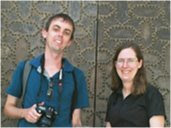I think I've mentioned that in my everyday life I am a
designer. I am trained as a graphic designer, and regularly employ my skills as a book designer in publishing my own
books. However, I primarily work as an embroidery designer. Because of that I have pretty good sewing skills, and occasionally try my hand at drafting my own patterns. (Oh, how I would LOVE to do a pattern drafting course to really understand garment construction...!) I think I have also mentioned that I am currently working on designing my ideal bag for my personal requirements.
With all that out of the way, by way of background, I now come to my main point:
Tom Bihn's Aeronaut bag is a work of design genius.
Now let me tell you why.
Good bags are made to last. The ones that last are the ones that don't develop spots of particular wear, because that's where holes are most likely to develop.
The places that are most likely to wear are along the edges. Most bag manufacturers get around this problem by putting vinyl piping along the edges. This is pretty ugly, and also adds to the weight. It does counteract the wear in those places though.
A far more stylish solution is to build it into the bag so that there are no sharp corners.

Let's think about your regular suitcase. Its basically a rectangular prism. (fig a)
Its pretty easy to round off some of those corners by rounding the corners of the end panels. (fig b) However, that still leaves us with a sharp edge at the ends. (fig c)
So how can you round that off as well?
Ok, shift your mind to thinking about a tennis ball. (fig d) It is covered in that weird felty sort of fabric. Its a sphere, but its covered in only two pieces.
By creating two curved, interlocking pieces (fig e), you can cover the whole tennis ball in two almost flat pieces of fabric (not completely flat, because felt has a bit of give, and will stretch somewhat around the ball shape too).
This is what Tom Bihn has done with the ends of his Aeronaut bag. By
curving the ends of the bag body into the end panels, he has managed to round off all the edges and corners of the bag. Pretty clever!
Seams add structure to a garment or in this case, a bag. You end up with a double thickness of fabric along the inside of the seam, in the form of a seam allowance. Along the length of the seam, this double thickness of seam allowance gives body. Tom has seams along (or near) most edges of the bag, which helps to give the bag structure, helping it to hold its shape.
However, seams are also naturally weak points across their joins. Its because they have only sewing thread to hold them together, which is not nearly as strong as the woven fabric itself. In looking at the Aeronaut, one of the things I noticed was that most of
the seams are curved. I figured there had to be a reason for it. (You wouldn't do it just for fun, because it would actually make sewing the bag together considerably harder, and time is money...) However I realised that by curving the seams, Tom has cleverly moved them away from any absolute edges of the bag (which are rounded anyway) to reduce the impact of these weak points being on the edges.
In having the separate end compartments, he has created "baffles" (by use of the internal walls) which also add structure to the bag, making it stronger and
less likely to bulge outwards. Bulging can be a concern for any soft-sided luggage, but the baffles cleverly help to minimise it.
I can see all of this just from analysing the pictures on the Tom Bihn website. I've never even seen one of these bags in the flesh, yet I can tell the guy is a genius. I take my hat off to him.
So the question you're probably asking is, "If you love it so much, why don't you just buy one?" The answer to that, my friend, is that unfortunately the genius Aeronaut is way too long for the maximum legal carry-on of the airline that I most regularly fly with. :-(













 I've mentioned before that I'd love to have some small enough (less than 100ml to comply with Liquids-Aerosols-Gels restrictions) ice bricks to keep things cool when we are travelling. I still haven't been able to find any, but this morning on the Kathmandu website, I found a product that is worth searching out:
I've mentioned before that I'd love to have some small enough (less than 100ml to comply with Liquids-Aerosols-Gels restrictions) ice bricks to keep things cool when we are travelling. I still haven't been able to find any, but this morning on the Kathmandu website, I found a product that is worth searching out:  Next time we may take a
Next time we may take a 


